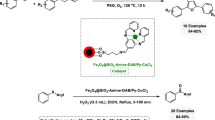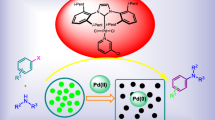Abstract
Seven carboxylate Sn(IV) complexes C1–C7 were synthesized by condensation between piperic acid with tri-phenylstannanol C1, piperic acidwith di-butylstannanone C2, phenylthioacetic acid with di-butylstannanone C3, 1,1′-(propane-1,3-diyl)-bis-(5-methyl-1H-pyrazole-3-carboxylic acid) with tri-phenylstannanol C4, 1,1′-(ox-ybis(ethane-2,1- di-yl))bis(5-methyl-1H-pyrazole-3-carboxylic acid) with tri-phenylstannanol C5, 1,1′-(propane-1,3-diyl)-bis-(5-methyl-1H -pyrazole-3-carboxylic acid) with di-butylstannanone C6 and 1,1′-(2-hydroxypropane-1,3-di-yl)bis(5-methyl-1H-pyrazole-3-carboxylic acid) with di-butylstannanone C7 these complexes characterized (by 13C NMR, 1H NMR and IR). Then the elaborated catalytic properties of these complexes were evaluated to catalyze the oxidation reaction of 3,5-di-tert-butylcatechol to 3,5-di-tert-butyl-o-benzoquinone. All the complexes showed good catalytic activity towards the oxidation reaction. Notably, complex C3 emerges as a standout performer, displaying remarkable catalytic activity in the oxidation of 3,5-di-tert-butylcatechol to 3,5-di-tert-butyl-o-benzoquinone. With a reaction rate of 14.45 μmol L−1 min−1 and an astonishing turnover (T) value of 21671.05 cycles per minute, C3 signifies a promising catalyst for future applications.









Similar content being viewed by others
References
Pellerito L, Nagy L (2002) Organotin (IV) n+ complexes formed with biologically active ligands: equilibrium and structural studies, and some biological aspects. Coord Chem Rev 224(1–2):111–150. https://doi.org/10.1016/S0010-8545(01)00399-X
Poller RC (1970) The chemistry of organotin compounds. Logos Press, London
Petrosyan VS (1977) NMR spectra and structures of organotin compounds. Prog Nucl Magn Reson Spectrosc 11(2):115–148. https://doi.org/10.1016/0079-6565(77)80005-8
Neumann WP (1970) The organic chemistry of tin. Interscience, London
Harrison PG (1989) Chemistry of tin. Springer, New York
Otera J, Dan-oh N, Nozaki H (1993) Unique template effects of distannoxane catalysts in transesterification of diol esters. Tetrahedron 49(15):3065–3074. https://doi.org/10.1016/S0040-4020(01)89888-4
Piver WT (1973) Organotin compounds: industrial applications and biological investigation. Environ Health Perspect 4:61–79. https://doi.org/10.1289/ehp.730461
Zuckerman JJ, Reisdorf RP, Ellis HV III, Wilkinson RR (1978) Organotins in biology and the environment, organometals and organometalloids. Chapter 24:388–424. https://doi.org/10.1021/bk-1978-0082.ch024
Hadjikakou SK, Hadjiliadis N (2009) Antiproliferative and anti-tumor activity of organotin compounds. Coord Chem Rev 253(1–2):235–249. https://doi.org/10.1016/j.ccr.2007.12.026
Ellahioui Y, Prashar S, Gomez-Ruiz S (2017) Anticancer applications and recent investigations of metallodrugs based on gallium, tin and titanium. Inorganics 5(1):4. https://doi.org/10.3390/inorganics5010004
Alderden RA, Hall MD, Hambley TW (2006) The discovery and development of cisplatin. J Chem Educ 83(5):728–734. https://doi.org/10.1021/ed083p728
Ho YP, Au-Yeung SC, To KK (2003) Platinum-based anticancer agents: Innovative design strategies and biological perspectives. Med Res Rev 23(5):633–655. https://doi.org/10.1002/med.10038
Sirajuddin M, Ali S (2016) Organotin (IV) carboxylates as promising potential drug candidates in the field of cancer chemotherapy. Curr Pharm Des 22(44):6665–6681. https://doi.org/10.2174/1381612822666160906143249
Banti CN, Hadjikakou SK, Sismanoglu T, Hadjiliadis N (2019) Anti-proliferative and antitumor activity of organotin (IV) compounds. An overview of the last decade and future perspectives. J Inorg Biochem 194:114–152. https://doi.org/10.1016/j.jinorgbio.2019.02.003
Ovejero-Paredes K, Díaz-García D, García-Almodóvar V, Lozano Chamizo L, Marciello M, Díaz-Sánchez M, Filice M (2020) Multifunctional silica-based nanoparticles with controlled release of organotin metallodrug for targeted theranosis of breast cancer. Cancers 12(1):187. https://doi.org/10.3390/cancers12010187
Anasamy T, Chee CF, Kiew LV, Chung LY (2020) In vivo antitumour properties of tribenzyltin carboxylates in a 4T1 murine metastatic mammary tumour model: enhanced efficacy by PLGA nanoparticles. Eur J Pharm Sci 142:105140. https://doi.org/10.1016/j.ejps.2019.105140
Barbieri R, Pellerito L, Ruisi G, Lo Giudice MT, Huber F, Atassi G (1982) The antitumour activity of diorganotin(IV) complexes with adenine and glycylglycine. Inorg Chim Acta 66(3):L39–L40. https://doi.org/10.1016/S0020-1693(00)85768-0
Nath M, Yadav R, Eng G, Musingarimi P (1999) Characteristic spectral studies and in vitro antimicrobial and in vivo multi-infection antifungal activities in mice of new organotin (IV) derivatives of heterocyclic amino acids. Appl Organomet Chem 13(1):29–37. https://doi.org/10.1002/(SICI)1099-0739(199901)13:1%3c29::AID-AOC809%3e3.0.CO;2-D
Huber F, Roge G, Carl L, Atassi G, Spreafico F, Filippeschi S, Di Bianca F (1985) Studies on the anti-tumour activity of di-and tri-organotin (IV) complexes of amino acids and related compounds, of 2-mercaptoethanesulphonate, and of purine-6-thiol. J Chem Soc Dalton Trans 3:523–527. https://doi.org/10.1039/dt9850000523
Barbieri F, Viale M, Sparatore F, Schettini G, Favre A, Bruzzo C, Alama A (2002) Antitumor activity of a new orally active organotin compound: a preliminary study in murine tumor models. Anticancer Drugs 13(6):599–604. https://doi.org/10.1097/00001813-200207000-00006
Carraher CE, Battin A, Shahi KR, Roner MR (2007) Synthesis, structural characterization, and initial evaluation as anticancer drugs of dibutyltin polyamines derived from various 4, 6-diaminopyrimidines. J Inorg Organomet Polym Mater 17(4):631–639. https://doi.org/10.1007/s10904-007-9159-7
Shuaibu MN, Kanbara H, Yanagi T, Ichinose A, Ameh DA, Bonire JJ, Nok AJ (2003) In vitro trypanocidal activity of dibutyltin dichloride and its fatty acid derivatives. Parasitol Res 91(1):5–11. https://doi.org/10.1007/s00436-003-0861-2
Sirajuddin M, Ali S (2013) Synthesis and characterization of potential bioactive organotins: azomethine based organotin (IV) complexes. LAP Lambert Academic Publishing, Saarbrücken
Boussalah N, Touzani R, Bouabdallah I, El Kadiri S, Ghalem S (2009) Synthesis, structure and catalytic properties of tripodal amino-acid derivatized pyrazole-based ligands. J Mol Catal A 306(1–2):113–117. https://doi.org/10.1016/j.molcata.2009.02.031
Titi A, Almutairi SM, Touzani R, Messali M, Tillard M, Hammouti B, El Kodadi M, Eddike D, Zarrouk A, Warad I (2021) A new mixed pyrazole-diamine/Ni(II) complex, crystal structure, physicochemical, thermal and antibacterial investigation. J Mol Struct 1236:130304. https://doi.org/10.1016/j.molstruc.2021.130304
Titi A, Shiga T, Oshio H, Touzani (2020) Synthesis of novel Cl2Co4L6 cluster using 1-hydroxymethyl-3, 5-dimethylpyrazole (LH) ligand: crystal structure, spectral, thermal, Hirschfeld surface analysis and catalytic oxidation evaluation. J Mol Struct 1199:126995. https://doi.org/10.1016/j.molstruc.2019.126995
Titi A, Warad I, Tillard M, Messali M, Touzani R (2020) Inermolecular interaction in [C6H10N3] 2 [CoCl4] complex: synthesis, XRD/HSA relation, spectral and catecholase catalytic analysis. J Mol Struct. https://doi.org/10.1016/j.molstruc.2020.128422
Titi A, Zaidi K, Alzahrani AYA, El Kodadi M, Yousfi EB, Moliterni A, Hammouti B, Touzani R, Abboud M (2023) New in situ catalysts based on nitro functional pyrazole derivatives and copper (II) salts for promoting oxidation of catechol to o-quinone. Catalysts 13(1):162. https://doi.org/10.3390/catal13010162
El Boutaybi M, Titi A, Alzahrani AYA, Bahari Z, Tillard M, Hammouti B, Touzani R (2022) Aerial oxidation of phenol/catechol in the presence of catalytic amounts of [(Cl)2Mn(RCOOET)], RCOOET= Ethyl-5-Methyl-1-(((6-Methyl-3-Nitropyridin-2-yl)Amino)Methyl)-1H-Pyrazole-3-Carboxylate. Catalysts 12(12):1642. https://doi.org/10.3390/catal12121642
Titi A, Oshio H, Messali M, Touzani R, Warad I (2020) Synthesis and XRD of novel Ni 4 (µ 3–O) 4 twist cubane cluster using three NNO mixed ligands: hirshfeld, spectral, thermal and oxidation properties. J Cluster Sci 32:227–234. https://doi.org/10.1007/s10876-020-01780-0
Neves A, Rossi LM, Bortoluzzi AJ, Szpoganicz B, Wiezbicki C, Schwingel E, Ostrovsky S (2002) Catecholase activity of a series of dicopper (II) complexes with variable Cu− OH (phenol) moieties. Inorg Chem 41(7):1788–1794. https://doi.org/10.1021/ic010708u
Eicken C, Krebs B, Sacchettini JC (1999) Catechol oxidase—structure and activity. Curr Opin Struct Biol 9(6):677–683. https://doi.org/10.1016/S0959-440X(99)00029-9
Kupán A, Kaizer J, Speier G, Giorgi M, Réglier M, Pollreisz F (2009) Molecular structure and catechol oxidase activity of a new copper (I) complex with sterically crowded monodentate N-donor ligand. J Inorg Biochem 103(3):389–395. https://doi.org/10.1016/j.jinorgbio.2008.11.015
Guha A, Chattopadhyay T, Paul ND, Mukherjee M, Goswami S, Mondal TK, Das D (2012) Radical pathway in catecholase activity with zinc-based model complexes of compartmental ligands. Inorg Chem 51(16):8750–8759. https://doi.org/10.1021/ic300400v
Mouadili A, Attayibat A, Kadiri S, Radi S, Touzani R (2013) Catecholase activity investigations using in situ copper complexes with pyrazole and pyridine based ligands. Appl Catal A 454:93–99. https://doi.org/10.1016/j.apcata.2013.01.011
Dahmani M, Ettouhami A, El Bali B, Yahyi A, Wilson C, Ullah K, Imad R, Ullah S, Wajid S, Arshad F, Elmsellem H (2020) Organotin (IV) derivative of piperic acid and phenylthioacetic acid: synthesis, crystal structure, spectroscopic characterizations and biological activities. Mor J Chem 8(1):244–263. https://doi.org/10.48317/IMIST.PRSM/morjchem-v8i1.17762
Dahmani M, Et-Touhami A, Yahyi A, Harit T, Eddike D, Tillard M, Benabbes R (2020) Synthesis, characterization, X-ray structure and in vitro antifungal activity of triphenyltin complexes based on pyrazole dicarboxylic acid derivatives. J Mol Struct 1225:129137. https://doi.org/10.1016/j.molstruc.2020.129137
Dahmani M, Harit T, Et-touhami A, Yahyi A, Eddike D, Tillard M, Benabbes R (2021) Two novel macrocyclic organotin (IV) carboxylates based on bipyrazoledicarboxylic acid derivatives: syntheses, crystal structures and antifungal activities. J Organomet Chem 948:121913. https://doi.org/10.1016/j.jorganchem.2021.121913
Lente G (2015) Deterministic kinetics in chemistry and systems biology. Springer. https://doi.org/10.1007/978-3-319-15482-4
Author information
Authors and Affiliations
Corresponding author
Additional information
Publisher's Note
Springer Nature remains neutral with regard to jurisdictional claims in published maps and institutional affiliations.
Supplementary Information
Below is the link to the electronic supplementary material.
Rights and permissions
Springer Nature or its licensor (e.g. a society or other partner) holds exclusive rights to this article under a publishing agreement with the author(s) or other rightsholder(s); author self-archiving of the accepted manuscript version of this article is solely governed by the terms of such publishing agreement and applicable law.
About this article
Cite this article
Titi, A., Dahmani, M., Abbaoui, Z. et al. New catalysts based on carboxylate Sn(IV) complexes used in the oxidation reaction of 3,5-di-tert-butylcatechol to 3,5-di-tert-butyl-o-benzoquinone. Reac Kinet Mech Cat 137, 133–148 (2024). https://doi.org/10.1007/s11144-023-02525-6
Received:
Accepted:
Published:
Issue Date:
DOI: https://doi.org/10.1007/s11144-023-02525-6




